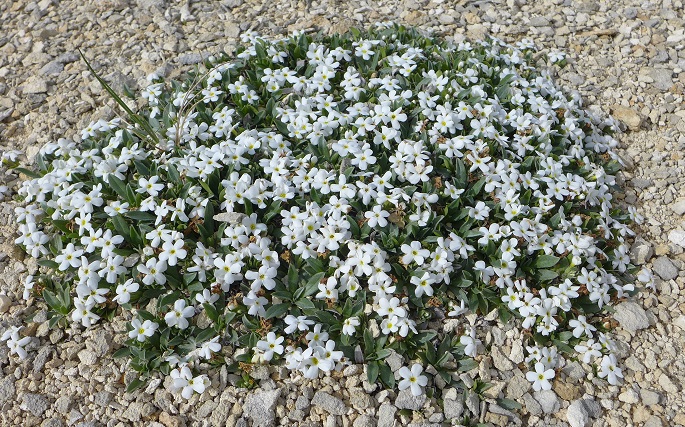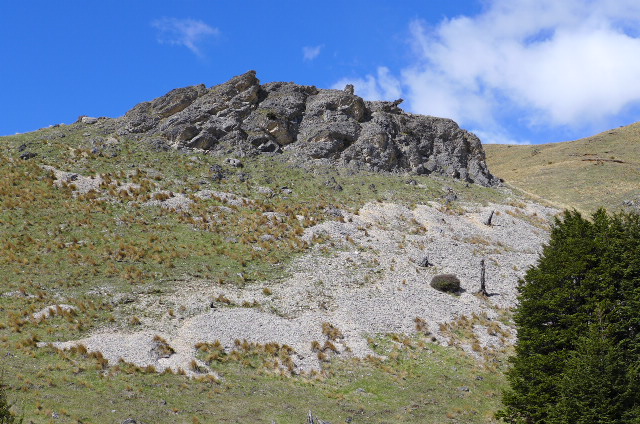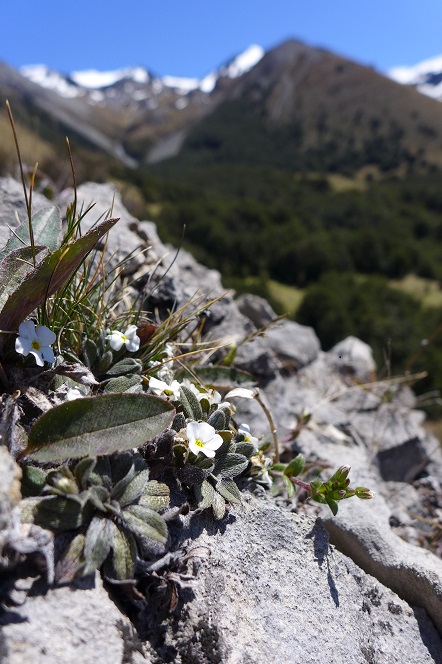Debra Wotton, Moa’s Ark Research Principal Ecologist
On a trip to Castle Hill Basin, Canterbury, in November 2022, Jane Gosden and I made the exciting and unexpected discovery of a previously unknown population of the Nationally Critical Castle Hill forget-me-not (Myosotis colensoi). This beautiful limestone endemic plant is restricted to just a handful of sites in Marlborough and Canterbury.

We set out on the Hogs Back Track in Craigieburn Forest Park, where Jane was hoping to find the grassland willowherb (Epilobium pictum), which is also critically endangered. Early on we noticed limestone rocks along the track, and so briefly searched (unsuccessfully) for limestone plants along Hogs Back. Back on the track, we spied a promising limestone bluff with talus slopes below, a couple of kilometres walk from our viewpoint. It was already late afternoon, but the lure of a possible new limestone discovery was too tempting. Abandoning the willowherb search, we headed to the limestone bluff.

Upon reaching the site, we searched the steep scree slope below the bluff but, disappointingly, found only weeds. But within minutes of commencing our search of the bluff itself, we were rewarded with the exciting discovery of several Castle Hill forget-me-not plants! With the light fading, we called it a day. We returned the next day to search the entire bluff system and ridgeline, recording more than 100 Castle Hill forget-me-not plants – all confined to the main bluff. The plants were mostly flowering and appeared healthy. However, the site is threatened by weeds, especially chewings fescue (Festuca rubra), which forms dense and extensive swards, and to a lesser extent tussock hawkweed (Hieracium lepidulum), which occupies crevices in limestone rocks that may otherwise be occupied by the forget-me-not. The limestone bluff is unnamed, so we have called it “Waterfall Bluff” after the creek that runs below.

To our knowledge, Castle Hill forget-me-not has not been sighted previously on Waterfall Bluff. There is one historic record of Castle Hill forget-me-not in this general area, collected by Walter Brockie “at head of Hogs Back Creek”. This specimen has no collection date but was probably collected sometime between 1928 and 1947, when Brockie was working at the Christchurch Botanic Gardens. The location described by Brockie suggests that the plant he found was more likely to be on nearby Hogs Back than on Waterfall Bluff.
Beyond the main bluff, the limestone formation extends along the ridgeline, with mostly small rocks above the surface and another large chunky scree slope below a second bluff part way along. This second scree slope has a fascinating and diverse stand of gnarly native shrubs with huge trunks – suggesting they are extremely old. Unfortunately, we couldn’t spend much time here, but it would be well worth further exploration – most limestone ecosystems have lost their native woody vegetation. We found no Castle Hill forget-me-not plants or other limestone endemics along the ridge, which has dense swards of non-native grasses. However, there were many other native plant species, especially among the rocks. Castle Hill forget-me-not was probably more widespread in this area in the past (prior to weed invasion), and other limestone endemics may also have occurred here.
This is an important find for the conservation of a critically endangered plant, and even more so because it is on Public Conservation Land. It is surprising that this population has not been discovered before, given its proximity to a walking track and the profusion of botanists in Canterbury. It just goes to show that exciting discoveries can still be made in relatively accessible areas – even when you’re looking for something else!